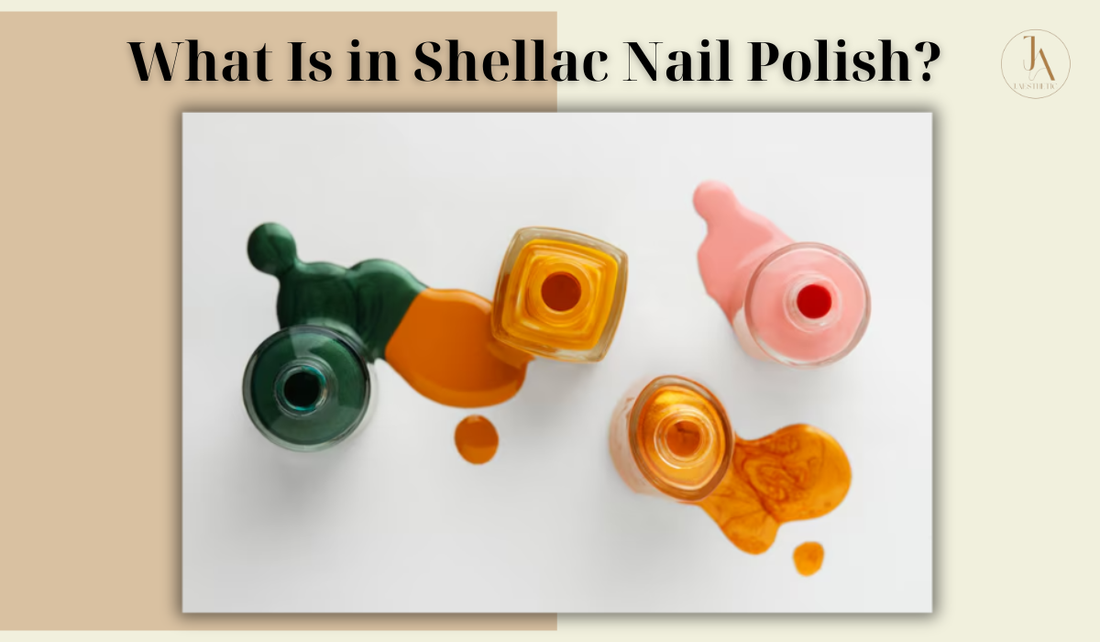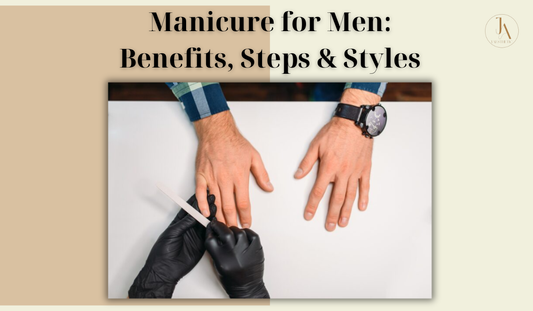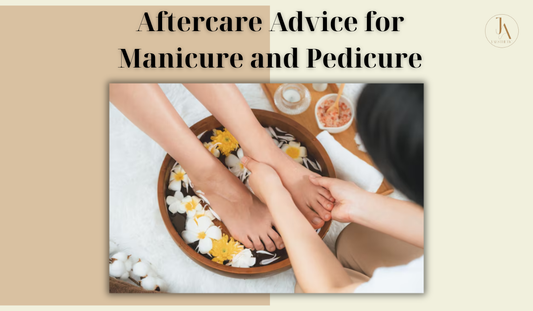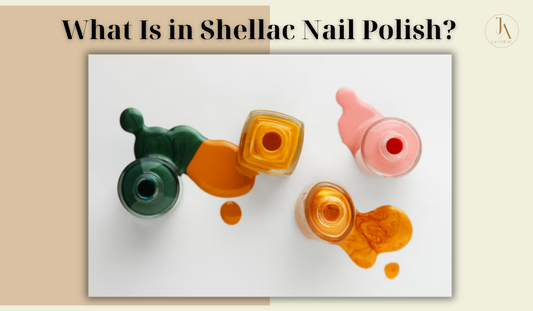
What Is in Shellac Nail Polish: Safe, Lasting Formula
Share
What is in shellac nail polish comes down to a precise blend of UV-reactive ingredients that combine beauty with durability. It contains methacrylate monomers, oligomers, photoinitiators, plasticisers, and colour pigments that harden into a smooth, glossy film when cured under UV or LED light. This chemistry allows shellac to deliver the shine of a gel, the flexibility of a lacquer, and the long-lasting wear that keeps manicures flawless for up to two weeks - making it a favourite for elegant, low-maintenance nails at J.Aesthetic in Sydney.

The Core Ingredients That Create Strength and Shine
To understand what is in shellac nail polish, it helps to break down how each ingredient contributes to its silky, salon-quality finish.
Shellac’s structure is built on methacrylate monomers, which act like small reactive molecules that bond together when exposed to UV or LED light. These molecules, often including HEMA (hydroxyethyl methacrylate) or HPMA, are responsible for the polish’s strong adhesion to the nail surface. They’re joined by oligomers - larger, pre-linked chains like urethane dimethacrylate - that add flexibility and toughness.
The magic happens when photoinitiators, such as camphorquinone or TPO, absorb light and activate the curing process. Supporting agents like plasticisers keep the finish flexible to prevent cracking, while UV stabilisers protect the colour from fading. Pigments and micas deliver the shades and shimmer that define every manicure, while solvents ensure a smooth application. Each ingredient plays a precise role in balancing durability, shine, and nail health.
Ingredient Safety and “Free-From” Shellac Formulas
The lasting power of shellac comes from the science of cross-linking - a process where monomers and oligomers form tight molecular bonds when exposed to light. This creates a three-dimensional network that resists chipping, scratching, and dullness.
Traditional nail polish dries by solvent evaporation, which leaves behind a soft film that can wear away easily. Shellac, by contrast, hardens from the inside out through photochemical reactions, ensuring the film stays intact even under daily stress. Its balanced flexibility allows the polish to move naturally with the nail, preventing cracks while maintaining a high-gloss finish.
For clients at J.Aesthetic’s Shellac Manicure Service, this technology means their manicure remains sleek, luminous, and perfectly intact through work, washing, and wear - without sacrificing comfort or breathability.

What Is in Shellac Nail Polish vs Gel and Regular Polish
When comparing formulas, shellac sits between a gel and a traditional lacquer - combining the durability of gel with the easy removal of regular polish. Understanding this difference is key for those choosing the right system for their nails.
Here’s how the chemistry varies:
|
Polish Type |
Core Ingredients |
How It Hardens |
Removal Method |
|
Shellac / Hybrid Gel |
Methacrylates, oligomers, photoinitiators, pigments |
Cures under UV/LED light |
Soak off with acetone wraps |
|
Hard Gel |
High-viscosity acrylates and oligomers |
UV/LED polymerisation in thick layers |
Filed off (non-soakable) |
|
Regular Polish |
Nitrocellulose, resins, and volatile solvents |
Air-dry through solvent evaporation |
Easily removed with nail polish remover |
Unlike hard gels, shellac polishes cure in thin, flexible layers and can be removed without damage when soaked properly. Compared to regular polish, shellac provides a glassy, chip-resistant film that stays vibrant for days longer.
The Role of Shellac Base and Top Coats
A shellac manicure isn’t just about the colour - it’s a layered system where each step plays a vital role.
The base coat includes adhesion promoters that bond the polish to the natural nail while protecting it from staining. These formulas are slightly acidic to create a strong surface connection without etching. The colour coat provides pigment and body, using stabilised monomers for even distribution and coverage. Finally, the top coat seals the deal with tough oligomers and gloss-enhancing agents that resist scratches and dullness.
Together, this tri-layer chemistry ensures long-lasting radiance. The base grips, the colour glows, and the top locks in a brilliant finish - each performing a unique yet harmonised function.

How the Ingredients in Shellac Nail Polish Cure Under UV and LED Light
Curing is where beauty meets science. When you wonder what is in shellac nail polish that reacts to light, the answer lies in photoinitiators - the ingredients that capture UV or LED energy and start the polymerisation process.
Under a lamp, these initiators release energy that links the polymer’s molecules into a solid structure. The lamp type matters: UV bulbs emit broad wavelengths suitable for camphorquinone, while LED lamps target narrower ranges for newer initiators like TPO.
After curing, some polishes leave a sticky inhibition layer - a thin, tacky residue that’s wiped off after the top coat. This layer helps each coat bond seamlessly, ensuring a flawless, cohesive film that won’t peel or lift.
What Is in Shellac Nail Polish Remover (and Why It’s Different)
The removal process is as carefully engineered as the polish itself. Since shellac forms a polymerised film, it doesn’t simply wipe off - it must be broken down chemically.
Removers typically use acetone as the active solvent, softening the cross-linked structure so it can gently slide away from the nail. To counterbalance acetone’s drying effects, premium removers include conditioning oils and humectants such as jojoba oil, glycerin, or vitamin E.
This method protects the natural nail and cuticle, avoiding the brittleness caused by aggressive scraping. Proper wrapping and soak times ensure a safe, smooth removal without compromising nail health.

What Is in Shellac Nail Polish: Ingredient Safety and “Free-From” Formulas
Consumers today care as much about safety as they do about style. That’s why understanding what is in shellac nail polish also means knowing what isn’t.
Modern brands have moved toward “7-free” or “10-free” formulations - excluding common irritants like toluene, formaldehyde, and DBP (dibutyl phthalate). Instead, they rely on cleaner methacrylate systems that remain safe when applied and cured professionally.
It’s important to note that methacrylates themselves are not dangerous when cured; issues only arise with prolonged contact with the uncured product. This is why professional curing, proper application, and full removal are essential steps for maintaining both nail integrity and skin safety.
Pregnant clients or those with sensitivities often choose salon brands with transparent ingredient disclosures and low-odour systems for peace of mind.
How to Apply Shellac Nail Polish for the Best Results
For those who want salon-quality results at home, applying shellac requires patience and precision. Follow these beauty-proven steps:
- Prep the nails: Cleanse the surface, remove oils, and lightly buff for smooth adhesion.
- Apply base coat: Use a thin layer, sealing the edge of each nail, then cure under the appropriate lamp.
- Add colour coats: Apply two ultra-thin layers, curing each for the full recommended time to ensure depth and durability.
- Seal with top coat: Lock in shine and protection, then cure again.
- Clean the surface: If a sticky layer remains, wipe with isopropyl alcohol.
- Hydrate and finish: Massage cuticle oil to restore moisture and add instant radiance.
At J.Aesthetic’s Manicure Service, this curing precision and layering expertise are what make every shellac manicure resilient, glossy, and salon-perfect.

Final Thoughts on Shellac Nail Polish
Shellac nail polish is where beauty, science, and precision meet. Its innovative blend of methacrylates, oligomers, and light-reactive agents delivers a finish that stays pristine far beyond regular polish. Whether you prefer classic nudes or bold statement shades, the chemistry behind shellac ensures that every manicure looks salon-fresh for days on end.
At J.Aesthetic in Sydney, every shellac application is guided by expertise, premium products, and gentle removal techniques - ensuring your nails remain strong, radiant, and flawlessly finished with every visit.
Book Your Gel Manicure in Sydney
From Soft Gel to Hard Gel, BIAB, Shellac and Polygel, J.Aesthetic in Gladesville offers custom gel manicure styles designed for every nail type and lifestyle. Experience expert care with a focus on precision, artistry, and lasting shine.
Book Your Appointment📍 267 Victoria Rd, Gladesville NSW 2111 | 📞 +61 2 3821 9828
FAQs: What Is in Shellac Nail Polish and Related Questions
Many clients researching what is in shellac nail polish also want to understand its chemistry, safety, and aftercare. The following FAQs provide detailed, beauty-focused insights.
What ingredients are in shellac nail polish?
Shellac typically contains methacrylate monomers, oligomers, photoinitiators, plasticisers, pigments, and stabilisers. Together, these allow it to harden quickly under light and maintain flexibility. Each brand varies slightly, but the principle remains: precision chemistry for high performance and long-lasting shine.
Does shellac damage nails?
When applied and removed correctly, shellac does not damage natural nails. The myth stems from improper removal - peeling or scraping rather than soaking. The polish itself forms a non-porous layer that protects nails, while modern formulas include conditioning agents to minimise dryness. Regular hydration with cuticle oil further supports nail health.
Is shellac vegan or cruelty-free?
Despite its name, modern shellac nail polish does not come from the lac beetle. The term now describes a UV-curable hybrid system. Many brands are vegan, cruelty-free, and toxin-free, though certification varies. Always check the brand’s transparency policy or Material Safety Data Sheet.
What is methacrylate in shellac polish?
Methacrylates are reactive molecules that solidify into a hard film when exposed to light. They’re what give shellac its signature strength and smoothness. Concerns only arise when the product is under-cured or applied on the skin, so professional curing and precision application ensure full safety.
How is shellac cured under UV or LED lamps?
Curing happens when the polish’s photoinitiators react to light wavelengths, triggering polymerisation. Each coat must be cured fully for structural integrity. Using the correct lamp - matched to the brand’s chemistry - prevents tackiness and ensures a glossy, durable result.
Are there toxic chemicals in shellac nail polish?
Most high-end shellac systems are free from harsh solvents, formaldehyde resin, and toluene. The remaining ingredients are carefully regulated and safe when used professionally. Always avoid low-quality, unlabelled products that may not meet safety standards.
Is shellac safe during pregnancy?
When applied in a well-ventilated environment and removed gently, shellac is considered safe for most expecting mothers. The key is to minimise exposure to solvents and ensure full curing. At J.Aesthetic, strict hygiene and gentle removal practices help protect both clients and their nails.



